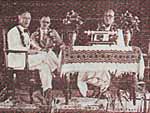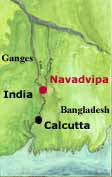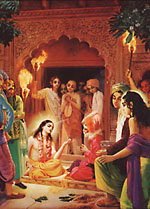


At the dawn of the 20th century an English nobleman surrounded by saffron clad monks in a remote village of rural India was surrounded an unusual sight. But Sir John Anderson's historical journey to the interior of British India was not for the economic or political motives that might ordinarily surround an English Lord's movements. As a highly qualified and cultured English gentleman, and the Governor of Bengal, Sir John Anderson was on an important research expedition to verify the exact location of the birthplace of Sri Chaitanya. Centuries earlier, at the time Columbus was discovering America, Sri Chaitanya Mahaprabhu had galvanized a spiritual renaissance resulting in movement of religious and social reform in India, known today as the "Bhakti Movement". The pure devotional system of yoga and religion He founded is followed-today by millions of people. Sir Anderson's intensive research had led him to the historical village of Mayapur on the bank of the sacred river Ganges in India's province of Bengal.
He faced a formidable obstacle. The unpredictable Ganges river had flooded the area and changed her course many times over the previous two centuries, hiding Sri Chaitanya's birthplace. It had also hidden valuable evidence needed by Anderson. But a breakthrough discovery by the great saint and spiritual master Thakur Bhaktivinode who had searched extensively for the birthplace of Sri Chaitanya gave him invaluable information.

Anderson studied rare old maps of the Ganges River basin found in the archives of the East India Company, the forerunner to British rule in India. He also personally visited the few remaining landmarks in the Mayapur area. One of these was the ruins of the palace and the tomb of the Mohammedan magistrate of the time. Authentic source literature from Sri Chaitanya's period provided descriptions of Sri Chaitanya's dealings with the magistrate giving essential evidence which enabled Sir Anderson to verify the exact location of the birthplace of Sri Chaitanya.
A study of Sri Chaitanya's daily life provided the required background. During the day, Sri Chaitanya, along with Sri Nityananda and other associates, would perform public chanting of the holy names of God throughout the town accompanied with drums and cymbals. They became renowned for their ecstatic dancing while singing the powerful Vedic mantras. Their principle chant was the "great chanting for deliverance" known as the maha-mantra: Hare Krishna Hare Krishna / Krishna Krishna Hare Hare / Hare Rama Hare Rama / Rama Rama Hare Hare.
There were two chanting congregations every day. In the evening Sri Chaitanya and His associates would gather together in the house of Srivas Thakur and chant throughout the night until daybreak. This nocturnal chanting could be heard by the Mohammedan magistrate from his bedroom.
Sri Chaitanya accepted devotees into His chanting party without consideration of caste, color, creed or other superficial designations. He taught from the Bhagavad-gita that every living being is a spiritual soul and a pure, eternal part and parcel of the Supreme Personality of Godhead. Sri Chaitanya taught everyone to see beyond the temporary bodily designations of country, family, society, and friendship by re-establishing their eternal relationship with the Supreme Lord through chanting His holy names. By this simple method He enlightened all He met to see not only their family members or fellow countrymen, but all living entities as their relatives. Sri Chaitanya ended the confusion of the Hindus, teaching them there was no need to worship demigods. Since the Supreme Lord Krishna alone was independent and supreme, all other living entities were subordinate to Him.
Sri Chaitanya's movement gained immense popularity. His universal teachings and His simple yet effective process of God-realization attracted countless followers. Sri Chaitanya inspired his followers to take up spreading of his message in a missionary spirit to unite all people in the world and deliver the fallen souls.
Sri Chaitanya Mahaprabhu's exceptional qualities and miraculous activities caused learned sages and renowned Vedic authorities to accept Him as the incarnation of God whose coming had been predicted thousands of years before in the Vedas.
However, everyone was not happy with Sri Chaitanya's spiritual revolution. His reforms were breaking the stranglehold of an age-old monopoly of powerful, self interested groups who were flaunting unjust hereditary rights which was against the Vedic principles. In response to this threat a group of local caste conscious brahmanas secretly lodged a complaint against Sri Chaitanya before the local Mohammedan magistrate or "Kazi", known commonly as the "Chand Kazi". The local brahmanas complained that Sri Chaitanya allowed persons of all castes and creeds to join the chanting of the names of God. This had previously been reserved for only priests or upper castes.
The Kazi took the complaints seriously and went with his constables to stop Sri Chaitanya's movement once and for all. He broke the clay drums of the chanting party and forbade them to chant the names of God in the areas under his jurisdiction. He threatened them with serious consequences if they refused to follow his order.
Lord Sri Chaitanya, normally mild and peaceful, became like a lion when he heard of the injustice of the Kazi depriving them of their basic religious freedoms. Sri Chaitanya soon organized a massive civil disobedience movement in Bengal to right these wrongs. A procession of over one hundred thousand men with thousands of mridanga drums and hand-cymbal karatalas marched through the streets chanting in defiance the Kazi who had issued the order.

Finally the procession reached the house of the Kazi who fled upstairs out of fear of the masses. The great crowds assembled at the Kazi's house displayed a violent temper, but Sri Chaitanya asked them to be peaceful. Although apprehensive, the Kazi finally agreed to come down and discussions were held between the two great scholars. Sri Chaitanya explained how the Vedic literatures have forbidden other forms of sacrifices, and have recommended the sankirtana sacrifice of congregational chanting of the Lord's holy names. The Chand Kazi became convinced and he declared that from then on no one should hinder the sankirtana movement of chanting Hare Krishna started by Sri Chaitanya.
Sir John Anderson measured the distances involved in the event. The Chand Kazi's ability to clearly hear Lord Chaitanya's party chanting during the night helped him to determine that the exact birthplace of Lord Chaitanya was in the some location found previously by Thakur Bhaktivinode. It was clearly within earshot of the Chant Kazi's residence.
Based on the extensive findings of Sir Anderson's research expedition, the British Government of India passed an order confirming Mayapur as the authentic and bonafide birthplace of Sri Chaitanya. Subsequently, a post was established at Mayapur and the government officially named the post office "Sri Mayapur." The added holy title "Sri" was given by the government in acknowledgment that Mayapur was a sacred place of pilgrimage.
The research of sacred places connected with Sri Chaitanya and His associates has not ended with Sir John Anderson. During the 20th Century almost all of the historical places connected with Sri Chaitanya have been located and verified. The life and philosophy of Sri Chaitanya Mahaprabhu is now available in English translations by His Divine Grace A.C. Bhaktivedanta Swami Prabhupada, the founder-acharya of ISKCON, in such works as The Teachings of Lord Chaitanya and Sri Chaitanya Charitamrita published by the Bhaktivedanta Book Trust. And according to predictions made by Sri Nityananda Prabhu, an eternal associate empowered by Sri Chaitanya Mahaprabhu to preach in Bengal, there is still history to be written. After Lord Sri Chaitanya departed from this world, Sri Nityananda Prabhu foretold that Mayapur would be covered for hundreds of years by the Ganges river flooding, and that after the flood waters would recede a spiritual city of devotees from all over the world would appear. Lord Sri Nityananda specifically described that there would be many temples in this city, but there would be one unique temple which would stand out amongst all the others. That glorious temple would firmly establish Lord Chaitanya's eternal principles of God consciousness all over the world.
On the order of His Divine Grace A. C. Bhaktivedanta Swami Prabhupada, the International Society for Krishna Consciousness has undertaken the formidable task of constructing the spiritual city and cultural center in Sri Mayapur that will fulfill the above prediction of Lord Sri Nityananda. Donations received for books distributed by the Society worldwide are helping to finance construction of the world of Chaitanya in Sri Mayapur. Everyone from all over the world is invited to participate in this adventure of making history, and to visit this place of pilgrimage, Sri Mayapur. Here you can see the spiritual city of the future developing before your very eyes-an ideal spiritual society of co-operation and living truth.